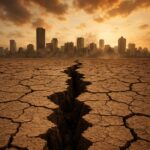Shaken Nations: What Recent Asian Earthquakes Teach Us About Preparedness and Resilience
In recent years, Asia has witnessed several powerful earthquakes that shook not only the ground beneath us but also the collective consciousness of millions. From Japan’s high-tech cities to the island communities of the Philippines and Indonesia, these seismic events serve as stark reminders that the region lies along the notorious Pacific Ring of Fire — one of the most earthquake-prone areas in the world.
But beyond the destruction, these earthquakes have also brought valuable lessons in preparedness, community resilience, and technological innovation. Let’s take a closer look at some of the recent major earthquakes in Asia and what they teach us about adapting to a world where the earth itself can shift without warning.
Recent Earthquakes That Shook Asia
1. The Philippines Mindanao Earthquakes
On October 10, 2025, a powerful 7.4-magnitude earthquake struck off the coast of eastern Mindanao in the Davao Oriental region of the southern Philippines, with its epicenter located approximately 17 km east of the town of Manay at a depth of about 58 km. The intense tremor triggered tsunami warnings across multiple coastal provinces, prompting mass evacuations and widespread alarm — although those warnings were later lifted after no major waves were recorded.
Later the same day, a 6.7 to 6.8-magnitude “doublet” quake struck the same general area, compounding fears of aftershocks and further damage. Several people lost their lives, with casualties reported due to building collapses, debris, landslides, and heart attacks in hospitals during the shaking. Infrastructure damage included cracked walls, bridges, and hospitals; utility outages and disruption of transport also affected the hardest hit communities. Authorities have launched search and rescue operations, assessed structural safety, and cautioned residents against returning to unsafe buildings amid the risk of powerful aftershocks.
For Filipinos, the quakes served as another wake-up call. The Philippines sits directly on several active fault lines, and experts have long warned of the “Big One” — a possible major earthquake near Metro Manila. These smaller quakes remind citizens of the urgent need for disaster preparedness education and stronger infrastructure in vulnerable regions.
2. The Japan coast of Honshu Earthquakes
On October 4, 2025, A magnitude 6.0 earthquake struck Japan late Saturday night, as reported by the National Center for Seismology. The tremor occurred in one of the world’s most active seismic zones, where Japan’s advanced monitoring systems detected the quake almost instantly. While no immediate reports of casualties or major damage were confirmed, authorities urged residents to remain vigilant and follow standard earthquake safety precautions as they continued to monitor potential aftershocks. The quake’s shallow epicenter increased its intensity, causing noticeable shaking across multiple regions, including areas near Tokyo.
Rescue and emergency response teams were quickly deployed to assess the situation and ensure public safety. Officials emphasized that while Japan’s infrastructure is built to withstand strong earthquakes, even moderate quakes can cause disruptions and pose risks in densely populated zones. The incident serves as another reminder of Japan’s vulnerability within the Pacific Ring of Fire, reinforcing the importance of constant preparedness, early warning systems, and public awareness in mitigating the impact of such natural events.
What These Earthquakes Teach Us
1. The Value of Early Warning Systems
Japan’s advanced early warning system remains one of the best in the world. Within seconds, it alerts citizens via TV, mobile phones, and public speakers — allowing people to protect themselves before the ground starts shaking. The Philippines and Indonesia are now working to enhance similar systems through partnerships with organizations like JICA (Japan International Cooperation Agency).
The takeaway? Seconds save lives. Investing in technology that detects seismic activity even a few moments earlier can make the difference between life and death.
2. Strength in Infrastructure and Design
Earthquakes do not kill — collapsing buildings do. This truth is at the heart of Japan’s strict building codes and engineering innovations. Structures are designed to sway instead of snap, absorbing seismic energy through flexible foundations and dampers.
Countries like the Philippines are gradually adopting these methods, but enforcement remains a challenge. Prioritizing earthquake-resilient construction — especially in schools, hospitals, and residential complexes — is essential for minimizing casualties.
3. Community Preparedness and Education
Disaster resilience starts at home. Japan’s culture of preparedness is woven into its school drills, workplace routines, and public campaigns. In contrast, many developing countries still lack consistent earthquake education.
Communities that know how to “Drop, Cover, and Hold On,” identify safe zones, and maintain emergency kits have far better chances of survival. The most powerful infrastructure, after all, is an informed population.
4. Post-Disaster Recovery and Mental Health
Beyond physical destruction, earthquakes leave invisible scars on survivors’ mental health. Aftershocks, loss, and displacement can trigger long-term trauma.
Recent disasters in Philippines and Japan showed the importance of mental health support and community rebuilding. Relief efforts now often include counseling, community events, and rebuilding local livelihoods — helping survivors heal not only physically but emotionally.
Building a Safer Future
As Asia continues to grow economically and technologically, the threat of earthquakes remains ever-present. Yet, these natural disasters also drive progress. They push governments, engineers, and communities to innovate — from early warning networks to flexible architecture and stronger public education campaigns.
In the Philippines, nationwide earthquake drills and the “ShakeDrill” campaigns are steps toward greater awareness. In Japan, continuous research in seismic prediction and engineering continues to inspire the world. And across Asia, each tremor reinforces a single truth: resilience is built, not born.
We may never stop the ground from shaking, but we can certainly learn how to stand stronger when it does.








